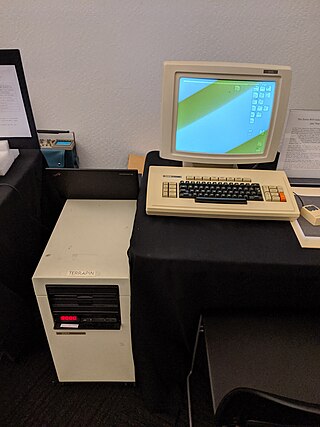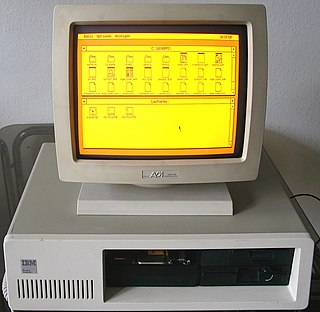
A context menu is a menu in a graphical user interface (GUI) that appears upon user interaction, such as a right-click mouse operation. A context menu offers a limited set of choices that are available in the current state, or context, of the operating system or application to which the menu belongs. Usually the available choices are actions related to the selected object. From a technical point of view, such a context menu is a graphical control element.

A graphical user interface, or GUI, is a form of user interface that allows users to interact with electronic devices through graphical icons and visual indicators such as secondary notation. In many applications, GUIs are used instead of text-based UIs, which are based on typed command labels or text navigation. GUIs were introduced in reaction to the perceived steep learning curve of command-line interfaces (CLIs), which require commands to be typed on a computer keyboard.

The history of the graphical user interface, understood as the use of graphic icons and a pointing device to control a computer, covers a five-decade span of incremental refinements, built on some constant core principles. Several vendors have created their own windowing systems based on independent code, but with basic elements in common that define the WIMP "window, icon, menu and pointing device" paradigm.

A multiple-document interface (MDI) is a graphical user interface in which multiple windows reside under a single parent window. Such systems often allow child windows to embed other windows inside them as well, creating complex nested hierarchies. This contrasts with single-document interfaces (SDI) where all windows are independent of each other.
In computing, a desktop environment (DE) is an implementation of the desktop metaphor made of a bundle of programs running on top of a computer operating system that share a common graphical user interface (GUI), sometimes described as a graphical shell. The desktop environment was seen mostly on personal computers until the rise of mobile computing. Desktop GUIs help the user to easily access and edit files, while they usually do not provide access to all of the features found in the underlying operating system. Instead, the traditional command-line interface (CLI) is still used when full control over the operating system is required.

An X window manager is a window manager that runs on top of the X Window System, a windowing system mainly used on Unix-like systems.

The Xerox Star workstation, officially named Xerox 8010 Information System, is the first commercial personal computer to incorporate technologies that have since become standard in personal computers, including a bitmapped display, a window-based graphical user interface, icons, folders, mouse (two-button), Ethernet networking, file servers, print servers, and email.

GEM is a discontinued operating environment released by Digital Research in 1985. GEM is known primarily as the native graphical user interface of the Atari ST series of computers, providing a WIMP desktop. It was also available for IBM PC compatibles and shipped with some models from Amstrad. GEM is used as the core for some commercial MS-DOS programs, the most notable being Ventura Publisher. It was ported to other computers that previously lacked graphical interfaces, but never gained traction. The final retail version of GEM was released in 1988.

In computing, a windowing system is a software suite that manages separately different parts of display screens. It is a type of graphical user interface (GUI) which implements the WIMP paradigm for a user interface.
In computing, a window is a graphical control element. It consists of a visual area containing some of the graphical user interface of the program it belongs to and is framed by a window decoration. It usually has a rectangular shape that can overlap with the area of other windows. It displays the output of and may allow input to one or more processes.

In computing, the desktop metaphor is an interface metaphor which is a set of unifying concepts used by graphical user interfaces to help users interact more easily with the computer. The desktop metaphor treats the computer monitor as if it is the top of the user's desk, upon which objects such as documents and folders of documents can be placed. A document can be opened into a window, which represents a paper copy of the document placed on the desktop. Small applications called desk accessories are also available, such as a desk calculator or notepad, etc.

Visi On is a graphical user interface (GUI)-based operating environment program for IBM compatible personal computers running MS-DOS. Visi On was developed by VisiCorp. It was one of the first GUIs on a personal computer. Visi On was never popular, as it had steep minimum system requirements for its day, but it was influential in the development of later GUIs like Microsoft Windows.

A window manager is system software that controls the placement and appearance of windows within a windowing system in a graphical user interface. Most window managers are designed to help provide a desktop environment. They work in conjunction with the underlying graphical system that provides required functionality—support for graphics hardware, pointing devices, and a keyboard—and are often written and created using a widget toolkit.
Z-order is an ordering of overlapping two-dimensional objects, such as windows in a stacking window manager, shapes in a vector graphics editor, or objects in a 3D application. One of the features of a typical GUI is that windows may overlap, so that one window hides part or all of another. When two windows overlap, their Z-order determines which one appears on top of the other.

Windows NT 3.51 is a major release of the Windows NT operating system developed by Microsoft and oriented towards businesses. It is the third version of Windows NT and was released on May 30, 1995, eight months following the release of Windows NT 3.5. The most significant enhancement offered in this release was that it provides client/server support for inter-operating with Windows 95, which was released almost three months after NT 3.51. Windows NT 4.0 became its successor a year later. Mainstream support for Windows NT 3.51 Workstation ended on December 31, 2000, and extended support ended on December 31, 2001, while Windows NT 3.51 Server mainstream support ended on September 30, 2000, followed by extended support on September 30, 2002. Both editions were succeeded by Windows NT 4.0 Workstation and Windows NT 4.0 Server, respectively.
The Start menu is a graphical user interface element that has been part of Microsoft Windows since Windows 95, providing a means of opening programs and performing other functions in the Windows shell. The Start menu, and the Taskbar on which it appears, were created and named in 1993 by Daniel Oran, a program manager at Microsoft who had previously collaborated on great ape language research with the behavioral psychologist B.F. Skinner at Harvard.

In computing, a tiling window manager is a window manager with an organization of the screen into mutually non-overlapping frames, as opposed to the more common approach of coordinate-based stacking of overlapping objects (windows) that tries to fully emulate the desktop metaphor.
A compositing manager, or compositor, is software that provides applications with an off-screen buffer for each window. The compositing manager composites the window buffers into an image representing the screen and writes the result into the display memory. A compositing window manager is a window manager that is also a compositing manager.
In user interface design, an interface metaphor is a set of user interface visuals, actions and procedures that exploit specific knowledge that users already have of other domains. The purpose of the interface metaphor is to give the user instantaneous knowledge about how to interact with the user interface. They are designed to be similar to physical entities but also have their own properties. They can be based on an activity, an object (skeuomorph), or a combination of both and work with users' familiar knowledge to help them understand 'the unfamiliar', and placed in the terms so the user may better understand.
In computing, focus stealing is a mode error occurring when a program not in focus places a window in the foreground and redirects all keyboard input to that window. This is considered to be an annoyance or hazard to some users because the program may steal the focus while the user is typing, causing keystrokes to go to the newly focused window, possibly being lost or causing an unintended effect therein. This may be a few keystrokes due to reaction time, or may be more if the user's attention is not on the computer screen, e.g. typing while looking at the keyboard or while reading copy to the side, or if processor lag causes a delay between the focus stealing event and the newly focused window displaying on the screen.













